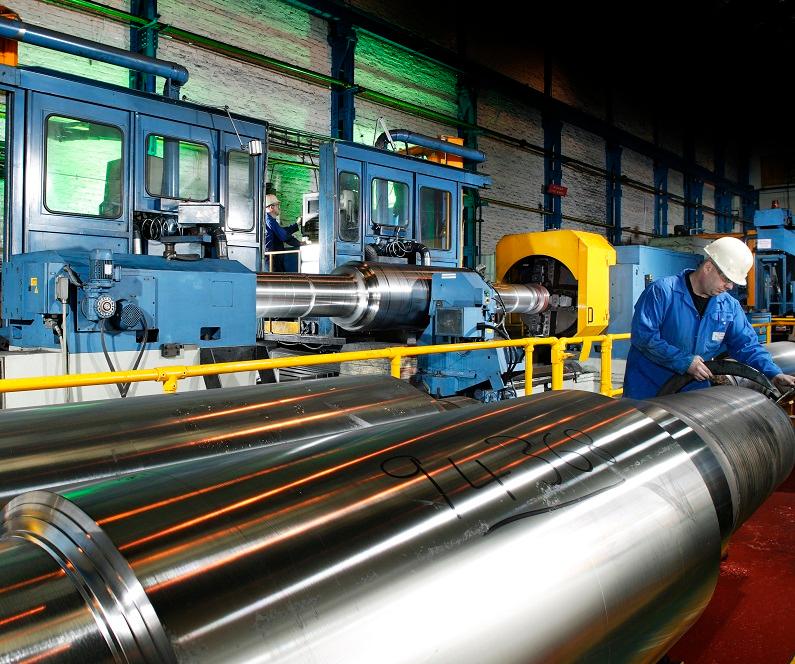Roll surface treatments & assessments

From the superb full conference programme scheduled for Rolls 6, we are now offering a selection of papers in a special series of Rolls for Metal Rolling Online Seminars. Presenters from research institutes and from the roll-making and roll-using industries will present the latest advances and new challenges in rolls technology developments, from scientific as well as industrial perspectives.
Two papers will deal with coatings on work rolls. The first paper presents a new, environment-friendly trivalent chromium-based plating process as possible replacement of the common hexavalent hard chrome process, illustrated with field experiences. The second paper proposes electroless nickel dispersion coatings with a broader field of application, not limited to cold mill work rolls but also to boost wear resistance on hot mill rolls. New developments in roll surface texturing will be discussed in the third paper. The final paper in this session, from a broad consortium comprising research institutes, roll users, a roll manufacturer and a measurement system supplier, will present a project enabling mill operators to perform fast roll surface analyses directly at the end of a rolling campaign, using tablets with quick measurements.
Experiences of Plating with a First Generation Trivalent Hard Chrome Process
Presented by Josep Sans, ATOTECH Deutschland
The usefulness and success of hard chrome plating since its industrial debut in the 1920s is of course unquestioned. However, with the latest legislations restricting the use of hexavalent chromium substances, is there finally a trivalent hard chrome process that can replace it?
After many years of research and development Atotech was able to successfully develop the first generation of trivalent hard chromium electrolyte. The new developed BluCr® process exhibits all the same benefits associated with Atotech’s hexavalent hard chromium processes; high hardness, high efficiency, low roughness, robustness and stability.
By showing some details and experiences of BluCr trivalent hard chrome process we hope to shed more light on the possible replacement of the hexavalent hard chrome process we know today.
The presentation will include field experiences on many had chrome usages around the world.
Electroless nickel dispersion coatings for roll protection against wear and hydrogen embrittlement
Presented by Jessica Schindhelm, VDeH-BFI
In hot and cold rolling, the surface of the rolls is subject to high wear. In both processes, the rolls experience high abrasion but additionally other wear mechanisms occur that are specific to the respective process.
The damage to rolls in hot forming is particularly high due to thermal and mechanical stress. Especially in hot profile rolling in some cases the grooves are subject to particularly high load peaks due to the geometries involved. In addition to abrasive wear, the high workpiece temperatures lead to thermal loads on the groove. During processing the temperatures of the near-surface layers vary in a range between 40 °C and 450 °C due contact with the hot workpiece and the necessary roll cooling. That generates high temperature alternating stresses in the rolls and leads to thermal fatigue effects. Low roll life and the need for frequent roll changes are the consequences.
A major roll degradation mechanism in cold rolling beside abrasive wear is roll fracture due to hydrogen embrittlement. Due to the use of rolling emulsion hydrogen diffuses into the surface of the tools and causes breakouts. The cases of work roll fracture in the cold rolling mills caused by hydrogen embrittlement are significantly increasing. One reason is the higher mechanical load that is needed due to the rolling of increasing amounts of high-strength strips especially narrow strips. Here, usually hard chromium coating are applied as a diffusion barrier but those are generated by Cr-VI decomposition which is supposed to be banned on European level.
For rolling processes it could be shown in recent projects, that electroless nickel dispersion coatings have high potential for reducing the degradation effects and actually offer an effective protection against mechanical wear, thermal degradation and hydrogen absorption. For the wear protections of hot profile rolling electroless nickel dispersion coating with particles of different materials, sizes, shapes and with different amounts of particle incorporations were evaluated with regard to their wear protection performances. Particles of silica, chromium and boron carbide in sizes between several ten nanometres and several hundred microns and in different particle shapes were screened for their use as dispersive phase in the coatings. In this evaluation the focus was on the abrasion (rubber wheel test according to ASTM G 65), spallation (impact jet according to DIN 50332 with glass beads), hot wear (2 rolls hot test bench) and adhesion behaviour (impact test with chisel) of the produced coatings. Results show, that the effects of the mentioned wear mechanisms can be significantly reduced by an electroless nickel coating with 0.8 µm boron carbide particles. In a second project it could be shown, that the application of an electroless nickel - boron carbide coating with a thickness of 10 to 15 µm on work rolls for cold rolling can reduce the hydrogen diffusion rate (permeation tests according to DIN EN ISO 17081) by an order of up to four magnitudes depending on the used work roll material. This can be interpreted as significant barrier effect for hydrogen. In both applications the fact, that electroless nickel - boron carbide dispersion coatings already show a quite high hardness which can be further improved by annealing played an important role.
Next-generation EDT technology
Presented by Chris Childs, Sarclad
Quality specifications for high grade textured steel and aluminium strip continue to increase. In line with its strategy of continued research and development in texturing technology, Sarclad has developed the next advance in Electrical Discharge Texturing to push roll texturing capabilities above and beyond the current requirements of the industry and into the next generation.
This paper details the development of the Next-generation EDT technology. It presents information on the revolutionised, high-efficiency electrical power delivery units and how these are combined with advanced digital closed-loop position control of each texturing electrode.
The effect of this development is to provide improved control of the cratering process that generates the texture on the roll. With this improved control the EDT machine is able to deliver high-quality textures benefiting from increased peak density and greater uniformity of texture when considering both the surface roughness (Ra) and peak count (RPc).
Additionally, the new technology will reduce the time required to texture a given roll, enabling higher throughput of rolls compared to any equivalent sized machine on the market, using any other texturing process.
Mastering Rolls II: fast work roll surface analyses with a tablet application
Presented by Jurgen Malbrancke, CRM Group
As a result of the continuously increasing productivity in the hot strip mill, the trend to roll thinner materials and the request of very high quality products, hot strip mills are facing more narrow tolerances and process windows. One of the major parameters influencing the production cost and the quality of the hot rolled strips is the degradation and thermal profile of the work rolls in the finishing mills. Rolls might look like just another piece of metal, but with the high temperatures and stresses to which they are exposed in modern mills, considerable demands are placed on roll materials and manufacturing processes.
To control the performances of the work rolls there is especially a need to have a better understanding and control of roll performance actuators, grinding rules and campaign scheduling. A key parameter is the measurement of the work roll surface state. Only with objective data of roll performance, controlled improvements can be introduced.
Within the European Project “Mastering Rolls II” (RFCS-2017-800748), which is the follow up of the European project “Mastering Rolls I” (7215-PP/066), a key part of this project is dedicated to the industrialization of innovative measurements that were developed over the past years. These can be divided in two type of measurements: in-depth measurements that take a larger amount of time (e.g.: NDT eddy current fire crazing and crack depth measurement, profile measurement, oxide thickness,…) and short measurements that allow a fast roll surface analyses directly at the end of a rolling campaign.
This presentation will focus on the short measurements that can be done by an operator by the help of a tablet. Within the European project “Intellub” (RFSR-CT-2013-0003) a tablet application was introduced to assist with the roll evaluation by guiding the user through an evaluation procedure. The first testing of this new technology at the mill immediately showed the improvements and innovations that are possible with the introduction of this new tool. Within the Mastering Rolls II project an industrialization of this technology is on-going at ArcelorMittal Ghent and Tata Steel IJmuiden.
Confirmed Speakers
Event Details
- The webinar will take place on Zoom
- The session will be recorded and all registrants will receive a link to watch on-demand
- The session will take place 13:00 - 15:00 BST
















